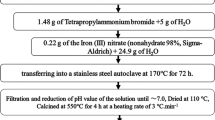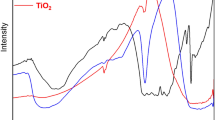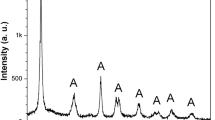Abstract
Due to unique properties, metal organic frameworks (MOFs) have attracted great research attention towards sustainable energy and environmental remediation. In this article, highly efficient TiO2@Ti(BTC) and TiO2/Ag2O@Ti(BTC) composites have been synthesized via in-situ incorporation of pre-synthesized TiO2 and TiO2/Ag2O into Ti-based MOF Ti(BTC) via facile refluxed method. All the synthesized samples have been successfully characterized by PXRD, SEM, EDX and UV-Visible spectroscopy. All these samples are used for study the photodegradation of methylene blue in aqueous solution under visible light irradiation. It has been found that incorporation of TiO2 NPs and TiO2/Ag2O nanocomposite into Ti(BTC) shifts the band gap towards more visible region, elevates the yield of O ∙–2 and OH∙– radicals and enhances the photodegradation efficiency of methylene blue in the presence of visible light. Amongst all the synthesized samples, TiO2/Ag2O@Ti(BTC) shows maximum photocatalytic activity towards photodegradation of methylene blue as compared to all other synthesized samples. It is observed that after 60 min, TiO2/Ag2O@Ti(BTC) shows minimum absorption of 0.02 as compared to TiO2 (0.17), TiO2/Ag2O (0.052), Ti(BTC) (0.32) and TiO2@Ti(BTC) (0.21). It reveals that methylene blue has been successfully degraded by synthesized samples and maximum activity has been shown by TiO2/Ag2O@Ti(BTC). Further, electrochemical water splitting activity of these samples has been studied. It has been found that TiO2/Ag2O@Ti(BTC) shows maximum catalytic activity towards both oxygen evolution reaction (OER) and hydrogen evolution reaction (HER). It generates maximum current density 97.15 and − 110 mA cm−2 towards both OER and HER, respectively, as compared to all other samples.
Graphic abstract








Similar content being viewed by others
References
V. Katheresan, J. Kansedo, S.Y. Lau, Efficiency of various recent wastewater dye removal methods: a review. J. Environ. Chem. Eng. 6(4), 4676–4697 (2018)
G.K. Gupta, H. Liu, P. Shukla, Pulp and paper industry–based pollutants, their health hazards and environmental risks. Curr. Opin. Environ. Sci. Health 12, 48–56 (2019)
R.L. Singh, P.K. Singh, Global environmental problems, in Principles and Applications of Environmental Biotechnology for a Sustainable Future. (Springer, Singapore. 2017), pp. 13–41
S. Bagheri, A.T. Yousefi, T.O. Do, Photocatalytic pathway toward degradation of environmental pharmaceutical pollutants: structure, kinetics and mechanism approach. Catal. Sci. Technol. 7(20), 4548–4569 (2017)
W.W. Anku, M.A. Mamo, P.P. Govender, Phenolic compounds in water: sources, reactivity, toxicity and treatment methods. in Phenolic Compounds-Natural Sources, Importance and Applications. (2017), pp. 420–443
S. Madhav, A. Ahamad, P. Singh, P.K. Mishra, A review of textile industry: wet processing, environmental impacts, and effluent treatment methods. Environ. Qual. Manag. 27(3), 31–41 (2018)
S. Mani, P. Chowdhary, R.N. Bharagava, Textile wastewater dyes: toxicity profile and treatment approaches, in Emerging and Eco-Friendly Approaches for Waste Management. Springer, Singapore. (2019), pp. 219–244
Y. Rasouli, M. Abbasi, S.A. Hashemifard, Investigation of in-line coagulation-MF hybrid process for oily wastewater treatment by using novel ceramic membranes. J. Clean. Prod. 161, 545–559 (2017)
M. Kamali, D.P. Suhas, M.E. Costa, I. Capela, T.M. Aminabhavi, Sustainability considerations in membrane-based technologies for industrial effluents treatment. Chem. Eng. J. 368, 474–494 (2019)
S. Jafarinejad, A comprehensive study on the application of reverse osmosis (RO) technology for the petroleum industry wastewater treatment. J. Water Environ. Nanotechnol. 2(4), 243–264 (2017)
N. Yahya, F. Aziz, N.A. Jamaludin, M.A. Mutalib, A.F. Ismail, W.N.W. Salleh, N.A. Ludin, A review of integrated photocatalyst adsorbents for wastewater treatment. J. Environ. Chem. Eng. 6(6), 7411–7425 (2018)
Y. Fan, J. Wang, M. Zhao, Spontaneous full photocatalytic water splitting on 2D MoSe 2/SnSe 2 and WSe 2/SnSe 2 vdW heterostructures. Nanoscale 11(31), 14836–14843 (2019)
A. Jabbar, M. Fiaz, S. Rani, M.N. Ashiq, M. Athar, Incorporation of CuO/TiO2 nanocomposite into MOF-5 for enhanced oxygen evolution reaction (OER) and photodegradation of organic dyes. J. Inorg. Organomet. Polym. Mater. 5, 92 (2020)
J. Yu, C. Mu, B. Yan, X. Qin, C. Shen, H. Xue, H. Pang, Nanoparticle/MOF composites: preparations and applications. Mater. Horiz. 4, 557–569 (2017)
A. Dhakshinamoorthy, A.M. Asiri, H. Garcia, Metal organic frameworks as versatile hosts of Au nanoparticles in heterogeneous catalysis. ACS Catal. 7, 2896–2919 (2017)
Q. Yang, Q. Xu, H.L. Jiang, Metal-organic frameworks meet metal nanoparticles: synergistic effect for enhanced catalysis. Chem. Soc. Rev. 46, 4774–4808 (2017)
D.Y. Du, J.S. Qin, S.L. Li, Z.M. Su, Y.Q. Lan, Recent advances in porous polyoxometalate-based metal-organic framework materials. Chem. Soc. Rev. 43, 4615–4632 (2014)
P. Falcaro, R. Ricco, A. Yazdi, I. Imaz, S. Furukawa, D. Maspoch, R. Ameloot, J.D. Evans, C.J. Doonan, Application of metal and metal oxide nanoparticles@MOFs. Coord. Chem. Rev. 307, 237–254 (2016)
Y.V. Kaneti, S. Dutta, M.S. Hossain, M.J. Shiddiky, K.L. Tung, F.K. Shieh, Y. Yamauchi, Strategies for improving the functionality of zeolitic imidazolate frameworks: tailoring nanoarchitectures for functional applications. Adv. Mater. 29(38), 1700213 (2017)
T. Kitao, Y. Zhang, S. Kitagawa, B. Wang, T. Uemura, Hybridization of MOFs and polymers. Chem. Soc. Rev. 46(11), 3108–3133 (2017)
Z. Chen, J. Chen, Y. Li, Metal–organic-framework-based catalysts for hydrogenation reactions. Chin. J. Catal. 38, 1108–1126 (2017)
X. Lian, Y. Fang, E. Joseph, Q. Wang, J. Li, S. Banerjee, C. Lollar, X. Wang, H.C. Zhou, Enzyme-MOF (metal-organic framework) composites. Chem. Soc. Rev. 46, 3386–3401 (2017)
C. Wang, Y.V. Kaneti, Y. Bando, J. Lin, C. Liu, J. Li, Y. Yamauchi, Metal–organic framework-derived one-dimensional porous or hollow carbon-based nanofibers for energy storage and conversion. Mater. Horizons. 5(3), 394–407 (2018)
C.C. Wang, X.D. Du, J. Li, X.X. Guo, P. Wang, J. Zhang, Photocatalytic Cr(VI) reduction in metal-organic frameworks: a mini-review. Appl. Catal. B Environ. 193, 198–216 (2016)
Y.M. Zhang, T.L. Dai, F. Zhang, J. Zhang, G. Chu, C.S. Quan, Fe3O4@UiO-66-NH2 core-shell nanohybrid as stable heterogeneous catalyst for Knoevenagel condensation. Chin. J. Catal. 37, 2106–2113 (2016)
F.P. Kinik, A. Uzun, S. Keskin, Ionic liquid/metal–organic framework composites: from synthesis to applications. ChemSusChem 10(14), 2842–2863 (2017)
S. Verma, R.B. Baig, M.N. Nadagouda, R.S. Varma, Fixation of carbon dioxide into dimethyl carbonate over titanium-based zeoliticthiophene-benzimidazolate framework. Sci. Rep. 7, 655 (2017)
S. Verma, R.B. Baig, M.N. Nadagouda, R.S. Varma, Titanium-based zeolitic imidazolate framework for chemical fixation of carbon dioxide. Green Chem. 18, 4855–4858 (2016)
Y.X. Liu, Y.Y. Geng, M.Y. Yan, J. Huang, Stable ABTS immobilized in the MIL-100(Fe) metal-organic framework as an efficient mediator for laccase-catalyzed decolorization. Molecules 22, 920 (2017)
C.D. Wu, M. Zhao, Incorporation of molecular catalysts in metal-organic frameworks for highly efficient heterogeneous catalysis. Adv. Mater. 29, 1605446 (2017)
W. Li, T. Zeng, Preparation of TiO2 anatase nanocrystals by TiCl4 hydrolysis with additive H2SO4. PloS One 6, e21082 (2011)
L. Bingkun, M. Lilong, H. Bing, Z. Jingtao, S. Hengzhen, Fabrication of TiO2/Ag2O heterostructure with enhanced photocatalytic and antimicrobial activities under visible light irradiation. Appl. Surf. Sci. 396, 1596–1603 (2017)
M. Fiaz, M. Athar, S. Rani, M. Najam-ul-haq, M.A. Farid, One pot solvothermal synthesis of Co3O4@UiO-66 and CuO@UiO-66 for improved current densitytowards hydrogen evolution reaction. Mater. Chem. Phys. 239, 122320 (2020)
W. Ying, C. Huiyong, X. Jing, L. Defei, L. Zewei, Q. Yu, X. Hongxia, Adsorptive separation of methanol-acetone on isostructural series of metal-organic frameworks M-BTC (M = Ti, Fe, Cu Co, Ru, Mo): a computational study of adsorption mechanisms and metal-substitution impacts. ACS Appl. Mater. Interfaces. 7, 26930–26940 (2015)
M. Fiaz, M. Athar, Facile room temperature In-situ incorporation of transition-metal selenide (TMSe) nanoparticles into MOF-5 for oxygen evolution reaction. JOM 72, 2219–2225 (2020)
M. Shafaee, E.K. Goharshadi, M. Mashreghi, M. Sadeghinia, TiO2 nanoparticles and TiO2@graphene quantum dots nanocomposites as effective visible/solar light photocatalysts. J. Photochem. Photobiol. A 357, 90–102 (2018)
B. Rusinque, S. Escobedo, H.D. Lasa, Photoreduction of a Pd-doped mesoporous TiO2 photocatalyst for hydrogen production under visible light. Catalysts 10, 74 (2020)
S. Mansingh, K.K. Das, A. Behera, S. Subudhi, S. Sultana, K. Parida, Bandgap engineering via boron and sulphur doped carbon modified anatase TiO2: a visible light stimulated photocatalyst for photo-fixation of N2 and TCH degradation. Nanoscale Adv. 2, 2004–2017 (2020)
M.G. Ha, E.D. Jeong, M.S. Won, H.G. Kim, Electronic band structure and photocatalytic activity of M-Doped TiO2 (M = Co and Fe). J. Korean Phys. Soc. 49, S675–S679 (2006)
Acknowledgements
Authors acknowledge Institute of Chemical Sciences, BZU, and Dr. Athar’s Research Lab for providing lab facilities for this work.
Author information
Authors and Affiliations
Corresponding author
Ethics declarations
Conflict of interest
Authors declare no conflict of interest.
Rights and permissions
About this article
Cite this article
Hussain, H.M., Fiaz, M. & Athar, M. Facile refluxed synthesis of TiO2/Ag2O@Ti-BTC as efficient catalyst for photodegradation of methylene blue and electrochemical studies. J IRAN CHEM SOC 18, 1269–1277 (2021). https://doi.org/10.1007/s13738-020-02109-4
Received:
Accepted:
Published:
Issue Date:
DOI: https://doi.org/10.1007/s13738-020-02109-4




